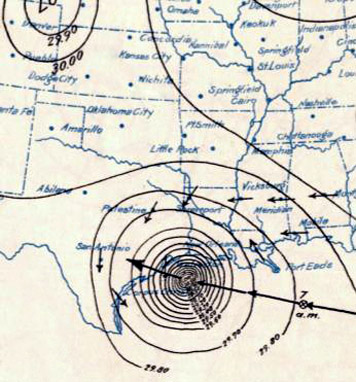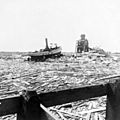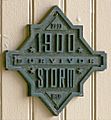1900 Galveston hurricane facts for kids
| Category 4 major hurricane (SSHWS/NWS) | |

Surface weather analysis of the hurricane on September 8, just before landfall.
|
|
| Formed | August 27, 1900 |
|---|---|
| Dissipated | September 15, 1900 |
| (Extratropical after September 11, 1900) | |
| Highest winds | 1-minute sustained: 145 mph (230 km/h) |
| Lowest pressure | 936 mbar (hPa); 27.64 inHg |
| Fatalities | 8,000+ (Deadliest in U.S. history; fourth-deadliest Atlantic hurricane) |
| Damage | $35.4 million (1900 USD) ($1.097 billion in 2020 USD) |
| Areas affected | Lesser Antilles, Greater Antilles (Dominican Republic and Cuba landfalls), Turks and Caicos Islands, Bahamas, Gulf Coast of the United States (Texas landfall), Midwestern United States, Mid-Atlantic, New England, Eastern Canada |
| Part of the 1900 Atlantic hurricane season | |
The Great Galveston hurricane, also known as the Great Storm of 1900, was the deadliest natural disaster in United States history. It was also one of the deadliest Atlantic hurricanes ever.
This powerful storm caused between 6,000 and 12,000 deaths in the United States. Most official reports say about 8,000 people died. Most of these deaths happened in and around Galveston, Texas. The storm brought a huge rush of ocean water, called a storm surge. This surge was 8 to 12 feet (2.4 to 3.7 meters) high and covered the coastline.
The hurricane destroyed about 7,000 buildings in Galveston. This included 3,636 homes that were completely wiped out. Every single building in the city was damaged in some way. About 10,000 people in Galveston lost their homes. At that time, the city had fewer than 38,000 residents.
This terrible disaster ended Galveston's "Golden Era." This was a time when the city was growing and doing very well. The hurricane made people worried about investing money there. Instead, they started investing in nearby Houston. After the storm, three engineers created a plan to protect Galveston. They raised the island's shoreline by 17 feet (5.2 meters). They also built a 10-mile (16 km) long seawall to help stop future storm surges.
Contents
How the Storm Formed and Traveled
Journey Through the Caribbean
On August 27, 1900, a ship near the Windward Islands spotted a tropical storm. This was the first storm seen during the 1900 hurricane season. The storm moved slowly west-northwest. It entered the northeastern Caribbean Sea on August 30.
On September 2, the storm hit the Dominican Republic as a weak tropical storm. It got a little weaker as it crossed the island of Hispaniola. Later that day, it moved back into the Caribbean Sea. On September 3, the storm hit modern-day Santiago de Cuba Province in Cuba. It then slowly moved along Cuba's southern coast.
Strengthening in the Gulf of Mexico
The storm reached the Gulf of Mexico on September 6. There, it quickly grew stronger and became a hurricane. It continued to gain power and became a Category 4 hurricane. This means it had very strong winds, up to 145 mph (230 km/h). This was its strongest point, on September 8.
Hitting the USA and Canada
Landfall in Texas
Early on September 9, the hurricane hit land south of Houston, Texas. After moving inland, the storm quickly lost strength. By late on September 9, it was back to a tropical storm.
Moving Across the Continent
The storm then turned toward the east-northeast. It became an extratropical storm over Iowa on September 11. An extratropical storm is a type of storm that gets its energy from temperature differences, not warm ocean water. This extratropical system grew stronger as it sped across the Midwestern United States, New England, and Eastern Canada. It reached the Gulf of Saint Lawrence on September 13.
After hitting Newfoundland later that day, the storm moved into the far North Atlantic Ocean. It then weakened. The last parts of the storm were seen near Iceland on September 15.
Impact and Losses
Damage in the Caribbean and Southern USA
The great storm caused floods and severe thunderstorms in parts of the Caribbean. Cuba and Jamaica were especially affected. It is likely that much of South Florida had strong winds. However, the damage there was mostly minor.
Hurricane-force winds and storm surge also hit parts of southern Louisiana. But the storm did not cause much damage or deaths in that state.
Devastation in Texas
The hurricane brought strong winds and storm surge to a large part of east Texas. Galveston suffered the worst of the storm's impact.
Effects Across Other States and Canada
Farther north, the storm and its leftover parts continued to bring heavy rains and strong winds. These winds knocked down telegraph wires, signs, and trees in several states. People also died in other states. Fifteen people died in Ohio, six in Wisconsin, and two in Illinois. Two people died in New York, one in Massachusetts, and one in Missouri. The total damage from the storm in the United States was over $34 million.
The storm's remnants also caused serious problems in Canada. In Ontario, the damage reached about $1.35 million, with $1 million of that being to crops. The storm caused at least 52 deaths in Canada. It might have caused as many as 232 deaths. Most of these deaths were from ships sinking near Newfoundland and the French territory of Saint-Pierre.
In total, the storm caused more than $35.4 million in damage along its entire path.
Related pages
Images for kids
-
Floating wreckage near Texas City – a common sight for miles along the waterfront
-
The Seawall in Galveston
See also
 In Spanish: Huracán de Galveston (1900) para niños
In Spanish: Huracán de Galveston (1900) para niños









